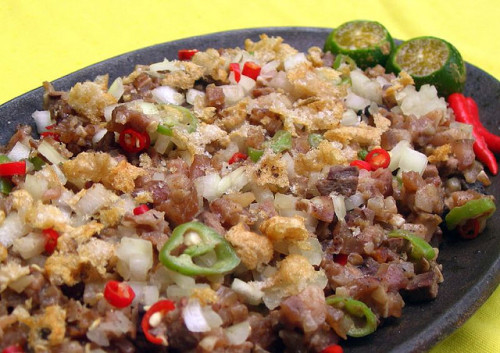Batute or Stuffed frog in english is also one of Kapampangan exotic dishes. They
also call this as "tugak" around Pampanga. It tastes like chicken and
it's really good.
Farmers in Pampanga used to depend on rain water to irrigater
their farms. Children would then catch the frogs, which came out during the
rainy season, while their parents cultivated the land or planted rice.
Outwitting the frogs has been a traditional "family bonding" ritual.
Betute is a play of words on butete, which means "tadpole" in the
local dialect. Betute is the entire frog stuffed with minced pork - so it looks
like a very fat frog. It is then deep-fried in oil.
Ingredients:
 1. 8 big edible frogs (palakang bukid)
1. 8 big edible frogs (palakang bukid)
2. 1/4 kilos ground
pork
3. 3 cloves of minced
garlic
4. 1/2 teaspoon salt
(for pork stuffing)
5. 1 tablespoon vinegar (for pork stuffing)
6. 1/2 teaspoon ground pepper (for pork stuffing)
7. 1 teaspoon of salt (for marinade)
8. 4 tablespoon of vinegar (for marinade)
9. 1 teaspoon ground pepper (for marinade)
10. 1 1/2 teaspoon brown sugar (for marinade)
5. 1 tablespoon vinegar (for pork stuffing)
6. 1/2 teaspoon ground pepper (for pork stuffing)
7. 1 teaspoon of salt (for marinade)
8. 4 tablespoon of vinegar (for marinade)
9. 1 teaspoon ground pepper (for marinade)
10. 1 1/2 teaspoon brown sugar (for marinade)
How to cook:
1. In a bowl, combine the ground pork, minced garlic, salt, vinegar and ground pepper. Set aside.
2. Clean the frog and remove the skin, head and cut the belly to remove the intestines.
3. Use the ground pork mixture as belly stuffing’s. Sew to prevent the stuffing’s from spilling out.
4. Mix the marinating mixture: salt, vinegar, ground pepper and brown sur.
5. Pour into the stuffed frogs.
6. Let it stand for 30 minutes.
7. The let it sun-dried for another 30 minutes.
8. Deep fry until golden brown.
9. Serve with fried rice or steamed plain rice.
1. In a bowl, combine the ground pork, minced garlic, salt, vinegar and ground pepper. Set aside.
2. Clean the frog and remove the skin, head and cut the belly to remove the intestines.
3. Use the ground pork mixture as belly stuffing’s. Sew to prevent the stuffing’s from spilling out.
4. Mix the marinating mixture: salt, vinegar, ground pepper and brown sur.
5. Pour into the stuffed frogs.
6. Let it stand for 30 minutes.
7. The let it sun-dried for another 30 minutes.
8. Deep fry until golden brown.
9. Serve with fried rice or steamed plain rice.
enjoy kabalen!






















